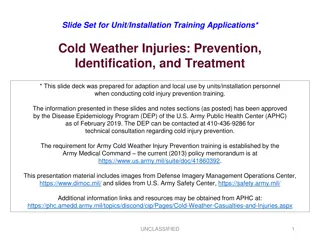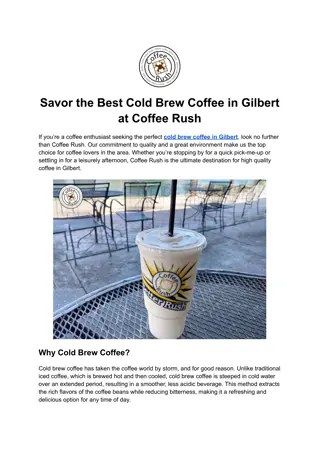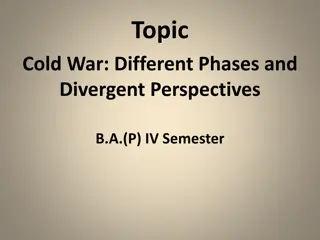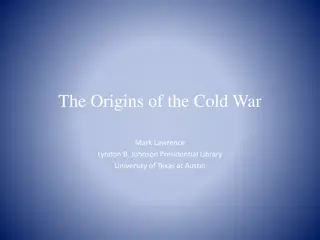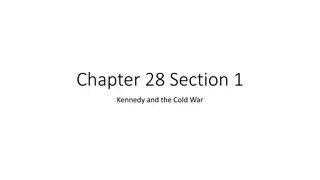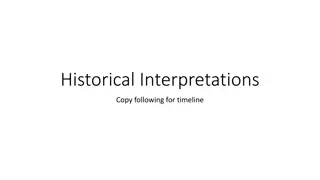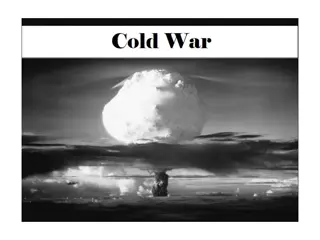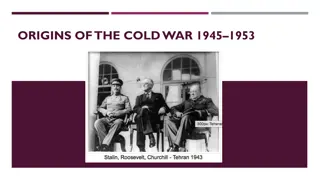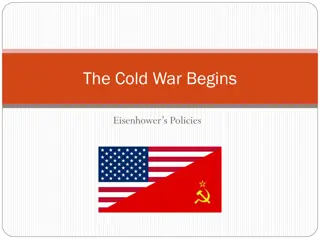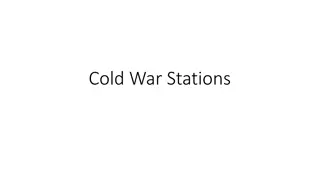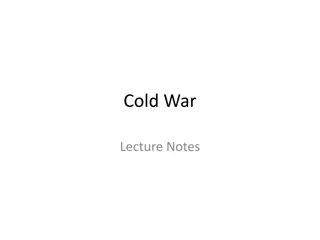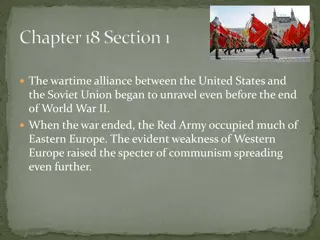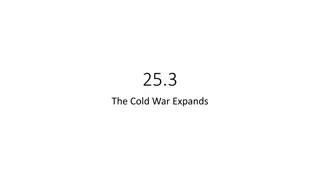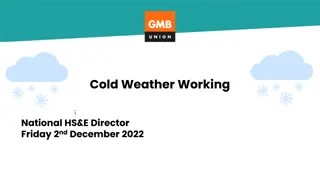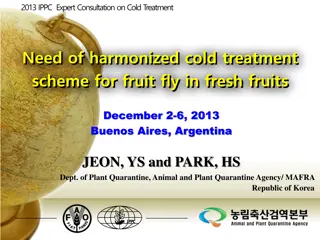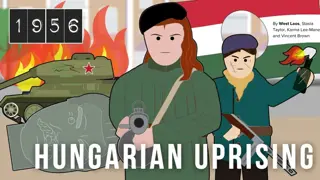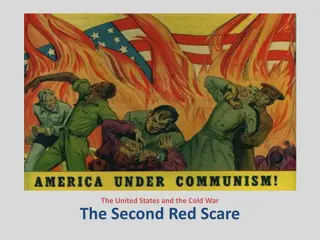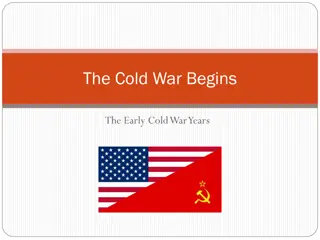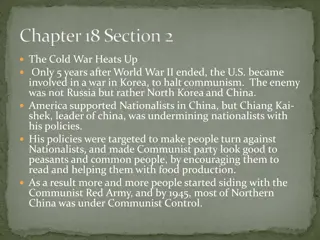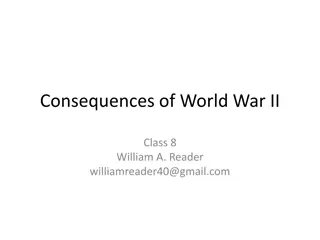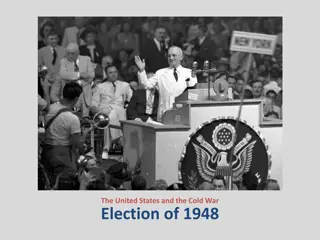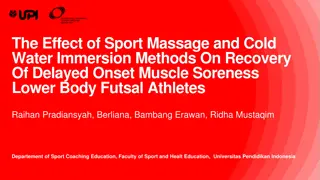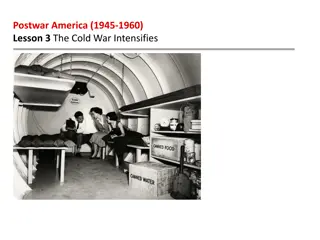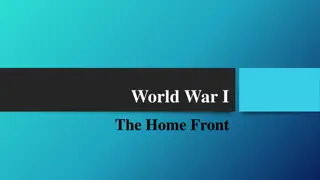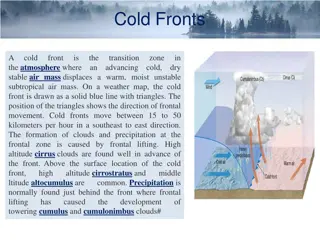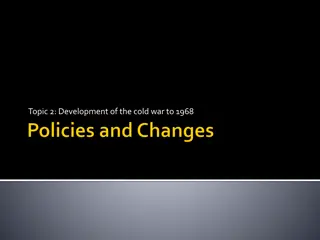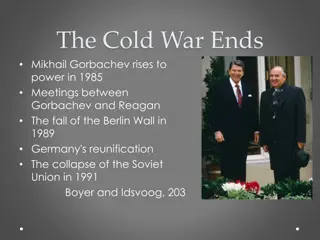Cold Weather Injuries Prevention Training
This slide deck focuses on preventing, identifying, and treating cold weather injuries. It emphasizes the responsibility of both individuals and commands in preventing cold injuries, highlighting factors contributing to susceptibility and methods for regulation body temperature in cold environments.
3 views • 41 slides
Savor the Best Cold Brew Coffee in Gilbert at Coffee Rush
Do you need that cup of coffee fix or a cup of juice to boost you up in Gilbert? Who can offer you the refreshing taste of Cold Brew Coffee in Gilbert? Coffee Rush does!Brewed from well-selected coffee beans, Special T Cold Brew Coffee is brewed using cold water for a longer time to give you the bes
1 views • 3 slides
Understanding the Cold War: Phases and Perspectives in B.A. IV Semester
Cold War, characterized by economic, political, and military competition between the US and Soviet Union, stemmed from ideological differences leading to global conflicts and proxy wars in the Global South, ultimately fueling neo-colonialism and neo-imperialism.
1 views • 15 slides
The Origins of the Cold War and U.S.-Soviet Antagonism
Amid post-World War II developments and contrasting ideologies, the Cold War emerged, marked by Yalta and Potsdam Conferences, the Truman Doctrine, the Marshall Plan, the Berlin Blockade, NATO's formation, and more. Various perspectives exist on the roots of U.S.-Soviet tensions, with the Soviet vis
1 views • 16 slides
The Homefront: U.S. War Production Efforts During World War II
During World War II, the United States mobilized its industries for total war production, converting peacetime factories into facilities for producing planes, tanks, rifles, and more. The U.S. became the Allies' biggest armaments supplier, producing millions of war supplies and significantly boostin
2 views • 25 slides
Kennedy and the Cold War: A Presidential Election and New Strategies
Kennedy's victory over Nixon in the 1960 presidential election paved the way for new Cold War strategies. Despite differences in upbringing, Kennedy's televised debate win and swift actions during unexpected events secured his narrow victory. With a focus on enhancing the nation's armed forces, Kenn
0 views • 17 slides
Cold War Historical Interpretations Timeline
Explore different historical interpretations of the Cold War through three main perspectives: Traditional/Orthodox, Revisionist, and Post-Revisionist/Contemporary/Post-1991. The Traditional/Orthodox view blames Stalin for the breakdown of relations, the Revisionist view points to mutual provocations
1 views • 9 slides
The Cold War: Rivalry and Tension Between Superpowers
The Cold War, lasting from post-World War II to the 1980s, was defined by political tension and rivalry between the United States and the Soviet Union. Despite never engaging in direct military combat, both sides competed through political maneuvering and propaganda, impacting global conflicts and t
0 views • 11 slides
Origins of the Cold War: Yalta and Potsdam Conferences 1945
The Cold War's origins stem from the tensions and suspicions between the USSR and the West post-World War II, highlighted through conferences like Yalta and Potsdam. At the Yalta Conference, held in February 1945, crucial decisions were made regarding Germany, Poland, and the UN. The Potsdam Confere
0 views • 10 slides
The Cold War Begins: Eisenhower's Policies and Achievements
President Dwight D. Eisenhower's era marked by the concept of massive retaliation, the space race, brinksmanship strategies, and efforts to combat communism. Eisenhower's leadership during the Sputnik Crisis and Korean War showcased his commitment to containing communism and advancing U.S. interests
6 views • 16 slides
Cold War Stations - Berlin Airlift and More
Delve into the historical events of the Cold War through the lens of key stations like the Berlin Airlift, Korean War, Sputnik, U-2 Incident, Berlin Wall, Marshall Plan, and Cuban Missile Crisis. Explore the significance of the Berlin Airlift, a pivotal moment in Cold War history, where Western alli
2 views • 54 slides
Overview of the Cold War: Tensions, Divisions, and Key Events
The Cold War was characterized by the rocky relationship between the U.S. and the Soviet Union, the division of Germany and Poland, the concept of the Iron Curtain, the Truman Doctrine, military alliances like NATO and the Warsaw Pact, and the political dynamics of the Korean War. Tensions over diff
0 views • 17 slides
The Unraveling of the Wartime Alliance and the Beginnings of the Cold War
The chapter delves into the breakdown of the wartime alliance between the United States and the Soviet Union post-World War II. Tensions rose as the Red Army occupied Eastern Europe and communism seemed to spread. The Marshall Plan's role in restoring Western Europe, coupled with events like the Cze
1 views • 15 slides
Innovations in Cold Storage Rack Design
Flamingo introduces a tool for designing efficient cold storage racks, addressing challenges in storing rarely accessed cold data at low cost. By leveraging innovative approaches like custom racks and resource optimization, the design complexity and performance impact are managed effectively. The so
0 views • 15 slides
The Cold War Expansion and Nuclear Arms Race
The Cold War intensified as the Soviet Union detonated an atomic bomb, leading to heightened tensions. Communist advancements, including the takeover of communist China, shocked the world. Nuclear arsenals expanded with the development of the hydrogen bomb, sparking concerns of an arms race. Eisenho
0 views • 17 slides
Understanding the Risks of Working in Cold Weather
Working in cold weather conditions can lead to various health risks, including frostbite, hypothermia, and musculoskeletal disorders. Employers should have policies and procedures in place to protect workers from the impacts of extreme cold, such as reduced performance and increased risk of accident
0 views • 20 slides
Harmonized Cold Treatment Scheme for Fruit Fly in Fresh Fruits Expert Consultation
The 2013 IPPC Expert Consultation in Buenos Aires, Argentina discussed the need for a harmonized cold treatment scheme for fruit flies in fresh fruits. The goal was to control regulated pests in international trade and suggest experiments for harmonizing cold treatment protocols. Prohibited articles
0 views • 13 slides
Hungarian Revolution of 1956: Impact on the Cold War
The Hungarian Revolution of 1956 marked a significant episode in the Cold War era, challenging Soviet dominance and leading to widespread consequences. The uprising, led by Imre Nagy, faced brutal Soviet suppression, resulting in thousands of casualties and reinforcing Soviet control over Hungary. T
0 views • 10 slides
Analysis of W.B. Yeats' Poetry During World War I
W.B. Yeats' poetry during World War I reflects a unique perspective on the conflict, as seen in works like "An Irish Airman Foresees His Death" and "On Being Asked for a War Poem." Delving into themes of sacrifice, duty, and the futility of war, Yeats offers a contrasting view to the graphic realism
0 views • 7 slides
Cold Weather Pit Count Coordinator Module 3 Planning for Success
Cold weather presents challenges for conducting pit counts to address homelessness. Visibility of homelessness decreases in cold weather, making locating individuals more challenging. Planning ahead with contingency dates, volunteer coordination, and route planning is crucial for success in cold wea
0 views • 11 slides
The United States and the Cold War: Historical Overview
The content explores the dynamics of the Cold War, focusing on China's internal conflict, the Korean Peninsula division, and the impact of the Second Red Scare in the United States. It delves into the feuds between different factions in China, the rise of communism, the Korean War phases, and the do
0 views • 15 slides
The Impact of the Korean War on Global Relations
The Korean War, often dubbed the "Forgotten War," had significant implications on global politics and relationships. This conflict was characterized by a mix of conventional and guerilla warfare tactics. China's involvement in the war had a profound impact on its relations with the U.S. and the U.S.
0 views • 14 slides
The Cold War Begins: Early Years and Containment Policies
The early years of the Cold War marked by conflicts between the United States and the Soviet Union, shaped by policies like the Long Telegram, Containment, Truman Doctrine, and the Marshall Plan. Tensions escalated with events such as the Crisis in Iran and the Berlin Crisis as the world grappled wi
0 views • 21 slides
The Cold War Heats Up: Korea and China Conflict
The post-World War II era saw the U.S. engaging in the Korean War to combat communism, facing off against North Korea and China instead of Russia. Conflict in China between the Nationalists led by Chiang Kai-shek and the Communists under Mao Tse-tung intensified, with Chiang's authoritarian rule spa
0 views • 14 slides
Advanced Cooling Solutions: ACS Cold Plate Focus Areas
Introduction to ACS Cold Plate focus areas led by Jessica Gullbrand from Intel. The objective is to standardize liquid-cooled solutions without hindering innovation. The ongoing focus includes approval of cold plate requirements, initiation of Open Rack V3 Blind Mate Liquid Cooling, and various work
0 views • 20 slides
Financial Impact of Cold Agglutinin Screen for Diagnosis of Cold Agglutinin Disease
Cold agglutinin disease, a rare form of autoimmune hemolytic anemia, accounts for 15% of AIHA cases. Implementing a cold agglutinin screen for diagnosis can have significant financial implications in healthcare costs. This condition is characterized by the presence of cold agglutinins, primarily IgM
0 views • 30 slides
Improving Southern Warehouse: Cold Storage Project Proposal
The Division of Food and Nutrition at agri.nv.gov is proposing a capital improvement project for the Southern warehouse to address challenges with third-party cold storage. The current arrangement has led to food spoilage, delivery delays, and compliance difficulties. The proposal aims to develop on
0 views • 10 slides
Analysis of Cold Fronts and Metal Distribution in Cluster A496
In a detailed study using XMM-Newton observations, the metal distribution and correlation with cold fronts in cluster A496 were analyzed. Cold fronts induced by minor mergers and sloshing mechanisms were investigated, revealing discontinuities and temperature variations indicative of cold fronts. Mu
0 views • 16 slides
Cold War and the Vietnam Conflict: A Historical Overview
Explore the tumultuous era of the Cold War and the Vietnam Conflict, including key events like the Cuban Missile Crisis, the Gulf of Tonkin incident, and the Tet Offensive. Discover how Cold War tensions shaped US military strategy and the struggles faced in Vietnam, from political unrest to militar
0 views • 18 slides
The Impact of World War II on Japan and the Emergence of the Cold War
World War II had far-reaching consequences on Japan, leading to significant naval battles, intense fighting in Okinawa, and ultimately, the country's surrender following the atomic bombings of Hiroshima and Nagasaki. The post-war period saw the emergence of the Cold War as tensions rose between the
0 views • 63 slides
The Election of 1948: Cold War, Truman, and Dixiecrats
The Election of 1948 was significant due to its context in the Cold War era, Truman's presidency, and the emergence of Dixiecrats. The Cold War, Truman Doctrine, Marshall Plan, and containment policy shaped the political landscape. Truman, Wallace, Dewey, and Thurmond were key candidates with contra
0 views • 8 slides
The Effect of Sport Massage and Cold Water Immersion on Muscle Soreness Recovery in Futsal Athletes
A study investigated the impact of sport massage and cold water immersion on recovery from delayed onset muscle soreness in lower-body futsal athletes. Results indicated that cold water immersion had a more significant effect on recovery compared to sport massage. The cold-water immersion method sho
0 views • 7 slides
The Cold War Escalates: Postwar America 1945-1960 Lesson 3
The period after World War II saw tensions intensify between the United States and the Soviet Union, leading to a global struggle for influence. The arms race, the space race, and significant international conflicts all heightened Cold War tensions. President Eisenhower's response to communism diffe
0 views • 17 slides
America's Role on the Home Front during World War I
During World War I, America witnessed significant changes on the home front as the government took on new powers to regulate industry, agriculture, and public opinion. Women and minorities played crucial roles, voluntary rationing was embraced, and opposition by conscientious objectors was met with
0 views • 24 slides
The War of 1812: Causes, Events, and Effects
The War of 1812 was influenced by issues such as British impressment of American sailors, arming Native Americans, and trade restrictions. Despite opposition, President James Madison declared war in 1812. The conflict marked a period of American nationalism, with War Hawks pushing for war and Doves
0 views • 16 slides
Understanding Cold Fronts and Occluded Fronts in Weather Systems
Cold fronts occur when advancing cold, dry air displaces warm, moist air, causing changes in temperature, winds, precipitation, and pressure. Occluded fronts result from a cold front overtaking a warm front, leading to the formation of mid-latitude cyclones. Different types of occlusions, like the c
0 views • 13 slides
Understanding the Cold War: Origins, Consequences, and Ideological Conflicts
Explore the origins, consequences, and ideological conflicts of the Cold War through key events like the Iron Curtain, Berlin Airlift, Korean War, and Cuban Missile Crisis. Learn about communism, democracy, and the impact of beliefs and ideals on attempts to stop the spread of communism during this
0 views • 16 slides
Understanding Death from Starvation and Cold: Mechanisms and Lesions
Starvation and cold can lead to death through specific mechanisms that affect the body's metabolism and tissue integrity. In cases of starvation, the body breaks down fat stores, leading to organ damage and eventual death. For cold-related deaths, exposure to extreme temperatures disrupts metabolic
0 views • 17 slides
Cold War Development to 1968
The Cold War escalated from the US providing support to countries threatened by communist expansion to the Soviet Union's policy of peaceful co-existence in the 1950s under new leadership like Nikita Khrushchev. Tensions rose with issues like Berlin becoming a free city proposal. The period also saw
0 views • 8 slides
The End of the Cold War: A Reflection on Nuclear Menace in the 1990s
Mikhail Gorbachev's rise to power in 1985 marked the beginning of the end of the Cold War, leading to significant events such as the fall of the Berlin Wall in 1989 and the reunification of Germany. Despite the waning nuclear arms race, nuclear themes continued to dominate mass culture in the late 1
0 views • 13 slides
